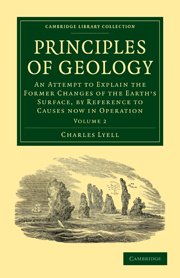 Principles of Geology
Principles of Geology Geographical Distribution and Migrations of Fish.
Although we are less acquainted with the habitations of marine animals than with the grouping of the terrestrial species before described, yet it is well ascertained that their distribution is governed by the same general laws. The testimony borne by MM. Péron and Lesueur to this important fact is remarkably strong. These eminent naturalists, after collecting and describing many thousand species which they brought to Europe from the southern hemisphere, insist most emphatically on their distinctness from those north of the equator; and this remark they extend to animals of all classes, from those of a more simple to those of a more complex organization, from the sponges and medusae to the cetacea. “ Among all those which we have been able to examine” say they, “ with our own eyes, or with regard to which it has appeared to us possible to pronounce with certainty, there is not a single animal of the southern regions which is not distinguished by essential characters from the analogous species in the northern seas.
The fish of the Arabian gulf are said to differ entirely from those of the Mediterranean, notwithstanding the proximity of these seas. The flying-fish are found (some stragglers excepted) only between the tropics,—in receding from the line they never approach a higher latitude than the fortieth parallel. Those inhabiting the Atlantic are said to be different species from those of the eastern ocean. The electric gymnotus belongs exclusively to America, the trembler, or Silurus electrims to the rivers of Africa; but the torpedo, or crampfish, is said to be dispersed over all tropical and many temperate seas.
To save this book to your Kindle, first ensure no-reply@cambridge.org is added to your Approved Personal Document E-mail List under your Personal Document Settings on the Manage Your Content and Devices page of your Amazon account. Then enter the ‘name’ part of your Kindle email address below. Find out more about saving to your Kindle.
Note you can select to save to either the @free.kindle.com or @kindle.com variations. ‘@free.kindle.com’ emails are free but can only be saved to your device when it is connected to wi-fi. ‘@kindle.com’ emails can be delivered even when you are not connected to wi-fi, but note that service fees apply.
Find out more about the Kindle Personal Document Service.
To save content items to your account, please confirm that you agree to abide by our usage policies. If this is the first time you use this feature, you will be asked to authorise Cambridge Core to connect with your account. Find out more about saving content to Dropbox.
To save content items to your account, please confirm that you agree to abide by our usage policies. If this is the first time you use this feature, you will be asked to authorise Cambridge Core to connect with your account. Find out more about saving content to Google Drive.